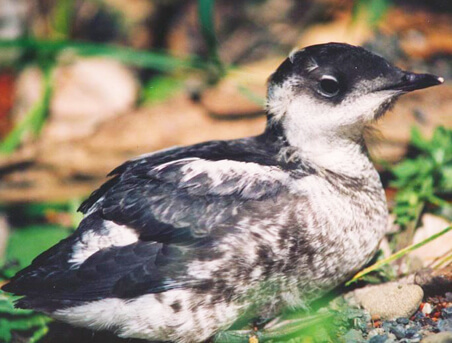Critical Habitat Revised for Marbled Murrelet in Northwest
Contact: Robert Johns, 202-234-7181 ext.210,
 |
| Marbled Murrelet chick, U.S. Forest Service |
(Washington, D.C.,
In December 2009, ABC and other environmental groups sent a letter to FWS opposing proposed changes in two counties in east-central Oregon. The letter said “…[we] are particularly concerned about the reduction of 62,700 acres [of Critical Habitat] in Lane and Douglas counties. This area is currently occupied by murrelets and the proposal is not supported by sound science.”
Based on these and other public comments and peer review, FWS concluded that the proposed reduction of Critical Habitat in Douglas and Lane Counties, Oregon is not adequately supported by current scientific literature and information. Accordingly, current Critical Habitat designations remain based on the best available scientific information.
“This decision reflects the best available science,” said Steve Holmer, Senior Policy Advisor at American Bird Conservancy. “We appreciate the changes made by the U.S. Fish and Wildlife Service to ensure areas of critical importance to the Marbled Murrelet will remain protected.”
The Critical Habitat revision in southern Oregon and northern California, however, was judged to be appropriate, based on the best available scientific information, which indicates the likely distribution of nesting birds is not as far inland as was delineated in 1996. FWS indicates that the best available information indicates the inland range of the murrelet from the Pacific Ocean is defined by the hemlock/tanoak habitat zone, rather than specific distance from the coast. Accordingly, they are removing approximately 189,700 acres of Critical Habitat in southern Oregon and northern California.
The Washington, Oregon, and California population of the Marbled Murrelet was federally listed as threatened in 1992. Critical Habitat was designated in 1996. In 1997, FWS approved a recovery plan for the Marbled Murrelet that specified actions necessary to halt the decline of the species.
The Marbled Murrelet is a small diving seabird of the alcid family, which also includes guillemots, auklets, puffins, and razorbills. Murrelets spend most of their lives foraging at sea in near-shore areas. They consume a diversity of prey species including small fish and invertebrates. Some murrelets nest on the ground along rocky coasts, but others nest in the trees of old-growth forests up to 50 miles inland. The presence of platforms (large branches or deformities) used for nesting is the most important characteristic of the nesting habitat of this tree-nesting population. The presence and abundance of mature and old-growth forests, large core areas of old-growth, low amounts of edge habitat, reduced habitat fragmentation, proximity to the marine environment, and forests that are increasing in stand age and height are critical to the murrelet’s survival.


















































